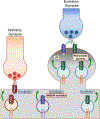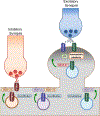Postsynaptic SNARE Proteins: Role in Synaptic Transmission and Plasticity
- PMID: 30458218
- PMCID: PMC6525081
- DOI: 10.1016/j.neuroscience.2018.11.012
Postsynaptic SNARE Proteins: Role in Synaptic Transmission and Plasticity
Abstract
Soluble N-ethylmaleimide sensitive factor attachment protein receptor (SNARE) proteins mediate membrane fusion events in eukaryotic cells. Traditionally recognized as major players in regulating presynaptic neurotransmitter release, accumulative evidence over recent years has identified several SNARE proteins implicated in important postsynaptic processes such as neurotransmitter receptor trafficking and synaptic plasticity. Here we analyze the emerging data revealing this novel functional dimension for SNAREs with a focus on the molecular specialization of vesicular recycling and fusion in dendrites compared to those at axon terminals and its impact in synaptic transmission and plasticity.
Keywords: neurotransmitter receptor trafficking; postsynaptic SNARE proteins; postsynaptic exocytosis; synaptic plasticity.
Copyright © 2018 IBRO. Published by Elsevier Ltd. All rights reserved.
Figures



Similar articles
-
Expression and function of SNAP-25 as a universal SNARE component in GABAergic neurons.J Neurosci. 2006 Jul 26;26(30):7826-38. doi: 10.1523/JNEUROSCI.1866-06.2006. J Neurosci. 2006. PMID: 16870728 Free PMC article.
-
GPCR regulation of secretion.Pharmacol Ther. 2018 Dec;192:124-140. doi: 10.1016/j.pharmthera.2018.07.005. Epub 2018 Jul 26. Pharmacol Ther. 2018. PMID: 30056056 Free PMC article. Review.
-
Investigating the Role of SNARE Proteins in Trafficking of Postsynaptic Receptors using Conditional Knockouts.Neuroscience. 2019 Nov 10;420:22-31. doi: 10.1016/j.neuroscience.2018.11.027. Epub 2018 Nov 24. Neuroscience. 2019. PMID: 30481567 Review.
-
Phosphorylation of Complexin by PKA Regulates Activity-Dependent Spontaneous Neurotransmitter Release and Structural Synaptic Plasticity.Neuron. 2015 Nov 18;88(4):749-61. doi: 10.1016/j.neuron.2015.10.011. Neuron. 2015. PMID: 26590346 Free PMC article.
-
Role of syntaxin 4 in activity-dependent exocytosis and synaptic plasticity in hippocampal neurons.Sci Signal. 2010 Oct 19;3(144):jc7. doi: 10.1126/scisignal.3144jc7. Sci Signal. 2010. PMID: 20959521 Review.
Cited by
-
Repeated oxytocin prevents central sensitization by regulating synaptic plasticity via oxytocin receptor in a chronic migraine mouse model.J Headache Pain. 2021 Jul 27;22(1):84. doi: 10.1186/s10194-021-01299-3. J Headache Pain. 2021. PMID: 34315403 Free PMC article.
-
Function of Drosophila Synaptotagmins in membrane trafficking at synapses.Cell Mol Life Sci. 2021 May;78(9):4335-4364. doi: 10.1007/s00018-021-03788-9. Epub 2021 Feb 22. Cell Mol Life Sci. 2021. PMID: 33619613 Free PMC article. Review.
-
AMPA Receptor Function in Hypothalamic Synapses.Front Synaptic Neurosci. 2022 Jan 31;14:833449. doi: 10.3389/fnsyn.2022.833449. eCollection 2022. Front Synaptic Neurosci. 2022. PMID: 35173598 Free PMC article. Review.
-
Neuronal SNAP-23 is critical for synaptic plasticity and spatial memory independently of NMDA receptor regulation.iScience. 2023 Apr 13;26(5):106664. doi: 10.1016/j.isci.2023.106664. eCollection 2023 May 19. iScience. 2023. PMID: 37168570 Free PMC article.
-
Can supplementation with antioxidants improve cognitive functions in patients with multiple sclerosis? A literature review.Ann Med Surg (Lond). 2025 Apr 16;87(5):2736-2748. doi: 10.1097/MS9.0000000000003124. eCollection 2025 May. Ann Med Surg (Lond). 2025. PMID: 40337414 Free PMC article. Review.
References
-
- Advani RJ, Bae HR, Bock JB, Chao DS, Doung YC, Prekeris R, Yoo JS, Scheller RH (1998), Seven novel mammalian SNARE proteins localize to distinct membrane compartments. J Biol Chem 273:10317–10324 - PubMed
Publication types
MeSH terms
Substances
Grants and funding
LinkOut - more resources
Full Text Sources

